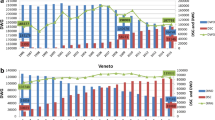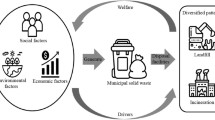Abstract
We explore the difference in cost structure when municipalities participate in intermunicipal cooperation (IMC) and estimate the minimal efficient scale, which minimizes the per capita service provision cost. The unit of analysis is designated as waste treatment provision area. We specify a cost function based on the Cobb–Douglas form that considers local environment variables, and illustrate the disparity between the current population and minimal efficient scale of the public service provision area. There are several key findings. First, being in an IMC affects the cost function by generating transaction costs, such as monitoring the quality of service provision, but the costs are discounted by population size. Second, the cost function is not linear to population, a downward convex function. Third, approximately 90% of the service provision areas in Japan have the opportunity to take advantage of economies of scale. However, geographical constraints render waste treatment with the framework of IMC more difficult, since such areas are separated by natural elements such as mountains. Nevertheless, the model in this study implies the possibility that municipalities can efficiently reduce public spending by participating in IMC authorities.




Similar content being viewed by others
Notes
Since the population is centered and the average logged population is 11.0233, the value in case \(\frac{{\partial \ln c_{i} }}{{\partial {\text{Coop}}_{i} }} = 0\) is \(\exp \left( {\frac{0.197}{0.089} + 11.0233} \right) \cong 560 ,633\).
References
Akaike H (1973) Information theory and an extension of the maximum likelihood principle. In: Petrov BN, Caski F (eds) Proceedings of the second international symposium on information theory. Akademiai Kiado, Budapest, pp 267–281
Allers MA, de Greef JA (2018) Intermunicipal cooperation, public spending and service levels. Local Gov Stud 44:127–150
Baba H, Asami Y (2017) Regional differences in the socio-economic and built-environment factors of vacant house ratio as a key indicator for spatial urban shrinkage. Urban Reg Plan Rev 4:251–267
Bel G, Costas A (2006) Do public sector reforms get rusty? Local privatization in Spain. J Pol Reform 9(1):1–24
Bel G, Mur M (2009) Intermunicipal cooperation, privatization and waste management costs: evidence from rural municipalities. Waste Manag 29(10):2772–2778
Bel G, Warner ME (2015) Intermunicipal cooperation and costs: expectations and evidence. Publ Adm 93(1):52–67
Bel G, Fageda X, Mur M (2012) Does cooperation reduce service delivery costs? Evidence from residential solid waste services. J Publ Adm Res Theor 24(1):85–107
Blaeschke F, Haug P (2018) Does intermunicipal cooperation increase efficiency? A conditional metafrontier approach for the Hessian wastewater sector. Local Gov Stud 44:151–171
Blesse S, Baskaran T (2016) Do municipal mergers reduce costs? Evidence from a German federal state. Reg Sci Urb Econ 59:54–74
Brown TL, Potoski M (2003a) Managing contract performance: a transaction costs approach. J Pol Anal Manag 22(2):275–297
Brown TL, Potoski M (2003b) Transaction costs and institutional explanations for government service production decisions. J Publ Adm Res Theor 13(4):441–468
Cobban TW (2017) Bigger is better: reducing the cost of local administration by increasing jurisdiction size in Ontario, Canada, 1995–2010. Urb Aff Rev. https://doi.org/10.1177/1078087417719324
Derksen W (1988) Municipal amalgamation and the doubtful relation between size and performance. Local Gov Stud 14(6):31–47
Diao K, Fu G, Farmani R, Guidolin M, Butler D (2015) Twin-hierarchy decomposition for optimal design of water distribution systems. J Water Res Plan Man 142(5):C4015008
Dijkgraaf E, Gradus RHJM (2008) Cost savings of contracting out refuse collection in the Netherlands. In: Dijkgraaf E, Gradus RHJM (eds) The waste market. Springer, Dordrecht, pp 9–21
Dijkgraaf E, Gradus RHJM (2014) Waste management in the Netherlands. In: Kinnaman TC, Takeuchi K (eds) Handbook on waste management. Edward Elgar Publishing, Cheltenham, pp 287–315
Drew J, Kortt MA, Dollery B (2014) Economies of scale and local government expenditure: evidence from Australia. Adm Soc 46(6):632–653
Drew J, Kortt MA, Dollery B (2016) Did the big stick work? An empirical assessment of scale economies and the Queensland forced amalgamation program. Local Gov Stud 42:1–14
Eggimann S, Truffer B, Maurer M (2015) To connect or not to connect? Modelling the optimal degree of centralisation for wastewater infrastructures. Water Res 84:218–231
Feiock RC (2007) Rational choice and regional governance. J Urban Aff 29(1):47–63
Fox WF, Gurley T (2006) Will consolidation improve sub-national governments? Policy Research Working Paper 3913. World Bank Publications. http://www1.worldbank.org/publicsector/decentralization/decentralizationcorecourse2006/OtherReadings/FoxGurley.pdf. Accessed 27 Oct 2018
Frère Q, Leprince M, Paty S (2014) The impact of intermunicipal cooperation on local public spending. Urb Stud 51(8):1741–1760
Genshin Y (1967) Theory and actual state of partial service authorities. Chiho-jichi 232:69–75
Geys B, Heinemann F, Kalb A (2007) Local governments in the wake of demographic change: Efficiency and economies of scale in German municipalities. Centre for European Economic Research. http://papers.ssrn.com/sol3/papers.cfm?abstract_id=997220. Accessed 8 Oct 2018
Guo T, Englehardt JD (2015) Principles for scaling of distributed direct potable water reuse systems: a modeling study. Water Res 75:146–163
Gyimah-Brempong K (1987) Economies of scale in municipal police departments: the case of Florida. Rev Econ Stat 69(2):352–356
Hayashi M (2002) Congestion, technical returns, and the minimum efficient scales of local public expenditures: an empirical analysis for Japanese cities. CIRJE-F-852 Discussion Paper, University of Tokyo, Tokyo
Hirsch WZ (1959) Expenditure implications of metropolitan growth and consolidation. Rev Econ Stat 41(3):232–241
Hirsch WZ (1965) Cost functions of an urban government service: refuse collection. Rev Econ Stat 47(1):87–92
Honma S (2012) Transition of municipal efficiency by Heisei’s great amalgamation. Kaikei-kensa Kenkyu 45:103–114
Hood C (1995) The “New Public Management” in the 1980s: variations on a theme. Acc Org Soc 20(2–3):93–109
Ikuyasu M, Zheng X-P (1998) The structure of administrative expenditure and optimal sizes of the Japanese municipalities. J City Plan Inst Jpn 33:13–18
Kidokoro T, Harata N, Subanu LP, Jessen J, Motte A, Seltzer EP (2008) Sustainable city regions: space, place and governance, vol 7. Springer, Berlin
Littlechild SC, Owen G (1973) A simple expression for the Shapley value in a special case. Manag Sci 20(3):370–372
Masuda H (2014) Disappearance of local entities. Chuokoron-Shinsha, Tokyo
Ministry of Internal Affairs and Communications (2017) White paper on local public finance. http://www.soumu.go.jp/menu_seisaku/hakusyo/chihou/29data/2017data/29czb01-06.html. Accessed 27 Oct 2018
Ministry of the Environment (2015) Survey on general waste treatment. http://www.env.go.jp/recycle/waste_tech/ippan/h27/index.html. Accessed 27 Oct 2018
Niaounakis T, Blank J (2017) Inter-municipal cooperation, economies of scale and cost efficiency: an application of stochastic frontier analysis to Dutch municipal tax departments. Local Gov Stud 43(4):533–554
Noda Y (2017) Forms and effects of shared services: an assessment of local government arrangements in Japan. Asia Pac J Publ Adm 39(1):39–50
Pavelescu FM (2011) Some aspects of the translog production function estimation. Rom J Econ 32(1):131–150
Seta F (2017) Regional governance and horizontal coordination in depopulating areas. In: Proceedings of 2017 international conference of Asian-pacific planning societies, pp 333–336
Soukopová J, Vaceková G (2018) Internal factors of intermunicipal cooperation: What matters most and why? Local Gov Stud 44:105–126
Stevens BJ (1978) Scale, market structure, and the cost of refuse collection. Rev Econ Stat 60(3):438–448
Tavares AF, Feiock RC (2017) Applying an institutional collective action framework to investigate intermunicipal cooperation in Europe. Perspect Publ Manag Gov. https://doi.org/10.1093/ppmgov/gvx014
Tiebout CM (1956) A pure theory of local expenditures. J Polit Econ 64(5):416–424
Varian H (1992) Economic analysis, 3rd edn. Norton, New York
Warner ME (2004) Inter-municipal cooperation in the U.S.: A regional governance solution? Urb Publ Econ Rev 6:221–240
Warner ME (2006) Market-based governance and the challenge for rural governments: US trends. Soc Pol Adm 40(6):612–631
Weese E (2015) Political mergers as coalition formation: an analysis of the Heisei municipal amalgamations. Quant Econ 6(2):257–307
Wooldridge JM (2015) Introductory econometrics: a modern approach. Nelson Education, Scarborough
Yokomichi K (2012) Considering modalities for wide-area cooperation in the future. Japan Center for Cities. http://www.toshi.or.jp/app-def/wp/wp-content/uploads/2015/01/eng01_08.pdf. Accessed 15 Mar 2019
Yokomichi K, Okino H (1996) Municipal amalgamation from the perspective of financial efficiency. Chiti Kenkyu 72(11):69–87
Yoshimura H (1999) Optimal scale of municipalities and municipal amalgamation. Toyo Keizai, Tokyo
Zafra-Gómez JL, Prior D, Plata-Díaz AM, López-Hernández AM (2013) Reducing costs in times of crisis: delivery forms in small and medium sized local government’s waste management services. Publ Adm 91(1):51–68
Zafra-Gómez JL, Pedauga LE, Plata-Díaz AM, López-Hernández AM (2014) Do local authorities use NPM delivery forms to overcome problems of fiscal stress? Span J Financ Acc 43(1):21–46
Acknowledgements
This work was supported by JSPS KAKENHI Grant Numbers 17K18919 and 18J11698. We are grateful to participants at the International Conference on Spatial Analysis and Modelling 2018 in Tokyo for their helpful comments.
Author information
Authors and Affiliations
Corresponding author
Additional information
Publisher's Note
Springer Nature remains neutral with regard to jurisdictional claims in published maps and institutional affiliations.
Appendix
Appendix
Based on the results in the analyses, it is possible to derive an estimation of the counterfactual cost reduction effect of being part of an IMC. Assuming that no municipalities are affiliated with IMC authorities, we calculated the differences in waste treatment spending between the actual and counterfactual settings. Utilizing the estimated coefficients retrieved from model III in Table 2, the values of local environment factors changed, because the IMC boundaries were delineated into municipal boundaries. Consequently, additional spending (i.e., the difference between actual and assumed spending), assuming that no municipalities are affiliated with IMC authorities, was computed as approximately 1380.96 billion yen, 1.81 times higher than actual spending. A comparison between actual and predicted spending in the counterfactual setting is illustrated in Fig. 5. Most predicted values are above the actual ones. Possibly, most municipalities are below their MESs and the shifted MESs in the counterfactual setting have smaller population sizes than those in the original ones. Since this prediction assumes that all municipalities have to deal with their waste treatment services on their own, it is an exaggerated case. Nevertheless, this estimation highlights how IMC helps reduce spending on waste treatment.
About this article
Cite this article
Baba, H., Asami, Y. Estimating the minimal efficient scale and the effect of intermunicipal cooperation on service provision areas for waste treatment in Japan. Asia-Pac J Reg Sci 4, 139–158 (2020). https://doi.org/10.1007/s41685-019-00119-6
Received:
Accepted:
Published:
Issue Date:
DOI: https://doi.org/10.1007/s41685-019-00119-6





